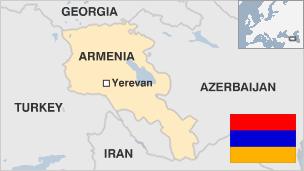Armenia profile - Overview
- Published

A landlocked country with Turkey to the west and Georgia to the north, Armenia boasts a history longer than most other European countries.
Situated along the route of the Great Silk Road, it has fallen within the orbit of a number of cultural influences and empires.
After independence from the Soviet Union in 1991, Armenia quickly became drawn into a bloody conflict with Azerbaijan over the mostly Armenian-speaking region of Nagorno-Karabakh.
One of the earliest Christian civilisations, its first churches were founded in the fourth century. In later centuries, it frequently oscillated between Byzantine, Persian, Mongol or Turkish control, as well as periods of independence.
Mount Ararat is an Armenian national symbol. It lies tantalizingly close but cruelly distant, just beyond the country's borders
Its rich cultural and architectural heritage combines elements from different traditions. The Armenian language is part of the Indo-European family, but its alphabet is unique.
Divided between the Persians and Ottomans in the 16th century, eastern Armenian territories became part of the Russian Empire in the early 19th century, while the rest stayed within the Ottoman Empire.
Between 1915 and 1917, hundreds of thousands of ethnic Armenians died at the hands of government troops in the Ottoman Empire.
Yerevan wants Turkey, and the world, to recognize the deaths as genocide, and some countries have done so.
However, Turkey says that there was no genocide and that the dead were victims of World War I, and that ethnic Turks also suffered in the conflict.
The governments of the two countries agreed to normalise relations in October 2009, but ratification has been stalled by new demands on both sides.
An independent Republic of Armenia was proclaimed at the end of the first world war but was short-lived, lasting only until the beginning of the 1920s when the Bolsheviks incorporated it into the Soviet Union.
When Soviet rule collapsed in 1991, Armenia regained independence but retained a Russian military base at Gyumri.
Territorial dispute
In the mid-1990s the government embarked on an economic reform programme which brought some stability and growth. The country became a member of the Council of Europe in 2001.
Unemployment and poverty remain widespread. Armenia's economic problems are aggravated by a trade blockade imposed by neighbouring Turkey and Azerbaijan since the dispute over Nagorno-Karabakh.
Despite these problems, Armenia's economy experienced several years of double-digit growth before a sharp downturn set in in 2008. Though the economy grew by about 7% in 2012, by the beginning of 2013 more than 30% of the population were still living below the poverty line.
The conflict over the predominantly Armenian-populated region in Azerbaijan overshadowed Armenia's return to independence.
Full-scale war broke out the same year as ethnic Armenians in Karabakh fought for independence, supported by troops and resources from Armenia proper. A ceasefire in place since 1994 has failed to deliver any lasting solution.
Armenia receives most of its gas supply from Russia and, like some other republics of the former Soviet Union, has had to face sharp price rises. Russian gas arrives via a pipeline running through Georgia.
Armenia has a huge diaspora and has always experienced waves of emigration, but the exodus of recent years has caused real alarm. It is estimated that Armenia has lost up to a quarter of its population since independence, as young families seek what they hope will be a better life abroad.
Armenia became the first country to adopt Christianity in about 300 AD